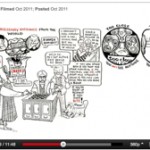I’ve tried many methods for treating my own depression over the years but have most consistently relied on medication and psychotherapy. Most of the therapies I’ve tried, however, have not produced lasting relief from the illness. I think that’s because they often miss the emotional core of depression. Instead of taking it on directly, most therapies try to bombard it from a strategic position outside the perimeter. Mostly, they emphasize words, ideas and reason to define new ways of thinking, making decisions and taking action. If those can change, so the theories say, then emotions and moods will follow their lead. That’s the promise.
If I can retrain my thought patterns, for example, if I can decide to act rather than ruminate, if I can speak about long-suppressed feeling and memories, if I can recognize destructive patterns of behavior, if I can achieve enough detachment from my thoughts to observe what they’re doing – in other words, if I can use my conscious mind to correct these and other distortions, then I will be able to get rid of depression, or at least keep it from dominating my life.
I’ve learned a lot from these cognitively-based approaches. In fact, they’ve given me essential skills. But they rarely reached directly into the painful emotions I lived with for so long, day after day for years. When I finally felt a fundamental turn toward recovery, I couldn’t understand exactly why or how that had happened. It seemed more like a gift than the result of conscious effort.
Recent Research
Recently, though, researchers and therapists have tried to explain what’s been missing and why recovery can seem so mysterious. They have found that there is a network of neural connections between those parts of the brain that relate to depression and several physical systems of the body. The research shows that a big part of our emotional lives arises unconsciously – beyond our cognitive ability to control. Perhaps that’s why my own change for the better has been so hard to explain.
Among the writer’s who have explained these discoveries are Antonio Damasio (The Feeling of What Happens) and the joint work of Lewis, Amini and Lannon (A General Theory of Love
). David Servan-Schreiber has focused more on the specific therapies linked to the unconscious emotional core of depression. He summarizes several forms of treatment based on this approach in his widely read The Instinct to Heal: Curing Depression, Anxiety, and Stress without Drugs and without Talk Therapy.
Servan-Schreiber is a psychiatrist who was involved in neuroscience research before developing his psychotherapy practice. After many years of working with his patients, he could see that something more than medication and talk therapy were needed. In his experience, psychotherapy that depended on language and thought to solve emotional problems often failed those who most needed help, as was also true for many who tried antidepressants. He began searching for alternatives to these mainstream treatments.
The Emotional Brain
Since his training was firmly rooted in western medicine and neuroscience, Servan-Schreiber approached alternatives with some skepticism and insistence on research that supported claims for their effectiveness. Eventually he identified several that he had seen work for his own patients and that also had solid research behind them. These are the methods he describes in The Instinct to Heal. As he explains, his experience and new evidence from neuroscience changed his whole approach to the treatment of depression, anxiety and other emotional disorders. He expresses the basis for his new approach in this way:
Inside the brain is an emotional brain … . This second brain is built differently, it has a different cellular organization, and it even has biochemical properties that are different from the rest of the neocortex, the most “evolved” part of the brain and the center of language and thought. …
The primary task of treatment is to “reprogram” the emotional brain … . To achieve this goal, it is generally more effective to use methods that act via the body and directly influence the emotional brain rather than use approaches that depend entirely on language and reason, to which the emotional brain is not as receptive.
The emotional brain contains neural mechanisms for self-healing: an “instinct to heal.” This instinct to heal encompasses the emotional brain’s innate abilities to find balance and well-being, comparable to other mechanisms of self-healing in the body, like the scarring of a wound or the elimination of an infection. Methods that act via the body tap into these mechanisms. (Instinct to Heal, 10-11)
As he also explains, though, the emotional and cognitive systems are constantly interacting. It’s not a question of relying on one or the other. Many of the treatments he describes, that focus on the brain’s emotional system, also have the effect of ending the obsessive, negative thinking characteristic of depression and inducing a more cheerful outlook by developing a sense of physical wellbeing. The feeling of harmony, he says, comes from a matching of emotional and cognitive activity. In that state, they are working together rather than in competition.
Treatments via Body and Emotional Brain
Many of the treatments Servan-Schreiber explores are familiar enough, such as the value of Omega 3 fatty acids in the diet, the importance of regular exercise, and the need to sustain loving relationships by improving the verbal communication of feelings. For each one, though, he draws together research findings that detail the neuroscience and biochemistry of their action on the emotional brain.
EMDR (Eye Movement Desensitization and Reprocessing), for example, helps the memory process traumatic events through the brain’s ability to associate physical sensations – like a taste or smell or texture – to long-forgotten events. By using the alternation of light signals, EMDR seems to help the brain mimic the sort of free associating the mind goes through during dreams. Often with surprising speed, PTSD patients, he reports, can unlock and process the violence of a past trauma that had haunted them for years.
A method called Cardiac Coherence developed directly as a result of the findings of neuroscience. These relate to the connections between parts of the autonomic nervous system, that controls basic functions like breathing and heartbeat independently of conscious thought, and areas of the brain linked to depression. As Servan-Schreiber describes the process, the sympathetic nervous system stimulates the heart, while the parasympathetic system puts a brake on that heightened activity.
Anxiety and depression distort the alternation of these influences to produce too much stimulation and keep the body in a state of stress. A key measure of this imbalance is a reduction in the variability of the heart rate – a serious problem seen in patients with failing hearts.
Cardiac Coherence relies on biofeedback. A person under high stress can learn to adjust the heart rate to a healthier pattern through the use of visualization techniques. By following a set of exercises while connected to a computer, patients see the results of their mental effort in a real time graph of the heart’s activity. The method can gradually instill an inner discipline that allows the calming effect of the process to be repeated without the use of computer software and hardware.
There are many other forms of treatment that have helped people heal themselves without the use of medication and talk therapy, or in combination with them. I’ll be devoting a series of posts to each of the most prominent approaches, mostly at the new site, Recover Life from Depression.
Have you made use of alternatives to medication and psychotherapy? Have they been helpful to you – perhaps even enough so that meds and talk therapy were no longer necessary?
Image by macrophile at Flickr




I’ve only recently found your blog and am so grateful for your posts. I struggle with long term treatment resistant depression (20 years). I do meds and therapy. I have a fairly constant low level depression and some bouts of major depression. Your blog is about the only thing I have found on the web that resonates with my own experience.
About 2 years ago I started seeing someone who does not only EMDR but a whole new wave of body-based therapies based on relatively new neuroscience (polyvagal theory, Stephen Porges) and trauma research (the main book here is Bessel Van Der Kolk’s the body keeps the score): “somatic experiencing” (Peter Levine), sensorimotor processing (Pat Ogden), NARM (Laurence Heller). There are lots of other authors who have good books that focus on applications and therapy using this stuff (Deb Dana, Kathy Kain, Rebekka LaDyne). You may have written about this on posts I haven’t read yet. I wanted to post this since 10 years ago most of this writing did not exist.
I was initially very excited about this approach because the theory offered an explanation for my worst and most puzzling symptom – a kind of morning ‘freeze’ that saps me of energy and motivation but tends to lift in the afternoon. I made some good progress (especially in being aware of how emotions produce sensations in my body, large and small). Lately, though, like all other therapies I’ve tried, progress is very slow, almost glacial, and breakthroughs are infrequent. A lot of people have had better luck with this than me, though, so I highly recommend it to your readers.
For those like me who are interested in what might come in the future, recent neuroscience has found evidence that a tiny part of our brain, the lateral habenula, plays a huge role in some fundamental depression symptoms (low motivation, low energy, anhedonia or inability to enjoy things). No therapies have come out of this “habenular theory of depression” yet, but you never know.
I’m glad that people are still trying to figure this out. Understanding the problem does not cure the depression, but it does give me hope and hope is so crucial for any recovery I have ever made.
I’m in talk therapy to dig out emotional stuff I want to process and get over but I off medication thanks to a neuro-feedback system called Brain Paint. I am fascinated by how effective this therapy has been (and also the fact that it’s covered by insurance!). I started by answered a set of questions that were evaluated by the Brain Paint application. The program then recommends a protocol. My process is this (I go twice a week now, I went 3 times a week for almost a year). I’m hooked up to electrodes for a Theta brain wave focused activity that includes asking how i’d like to see myself (suggestions are provided – more intuitive, calmer, etc. I also choose my own focuses). Then i’m asked to think of a pending stressful situation, imagine it over with ease, and then ask my subconscious to help me. Having gone though that I am asked to remember a time when I was feeling better “than I am now” for 1 minute and then let my mind wander. While my mind is wandering I’m listening to all sorts of interesting and somewhat melodic sounds. I also have two short Beta brain wave sessions where I look at fractals flashing on the screen and then click a mouse when I see the color blue on a different part of the computer screen. When I first started watching the fractal it was exhausting and I would literally fall asleep. Now I can watch them and relax most of the time. I wonder if this is like the EMDR you mentioned.
I also want to stress that what I have described is my protocol and it could be totally different for others.
The MIR Self-Healing Method is a method developed by Mireille Mettes , Dutch holistic therapist that relies on the repetition of a series of mental mandates that aim to make the mind ‘s grasp, assimilate and run to heal physical and emotional ailments .
In itself , the name of MIR , besides being the first three letters of the name of its author , means something like ” Intuitive Mental Reboot ” to like a computer, which slows or when it begins to fail, it should go off and become to switch again to load programs and re- start a work session.
When we get stuck repeatedly in the same thoughts and beliefs, our body responds to the meaning of all of them. Whether the person knows and feels sick ; problems and concerns, and therefore can not stop thinking about it . And the mind assumes that this is how the body should respond with pain, discomfort and symptoms of the disease are expected .
This method of self-healing , simply dictates that the natural powers of self-healing of the body must be activated by sentences that are installed in the subconscious , like a program is installed on the computer and thereafter, automatically operate whenever the device switches on .
Years ago, talk therapy and medication pulled me out of a serious depression. Years later, after stopping both, I found myself slipping back into depression. I’m extremely grateful to have been introduced to a therapist who uses EMDR. We’ve been working on my depression and self-loathing for five months now and I can feel my self-image genuinely shifting for the first time in my life. I like myself better, and although I’m back on talk therapy and medication, I know the EMDR is making changes that pills and talking cannot make. I think EMDR will make the second half of my life much less painful than the first half (I’m 44).
Hi, Regina –
Thanks for letting us know about your experience with EMDR. It must be great to feel that shift in self-image – and I’m glad you’ve found a method that helps with that breakthrough.
I’ve had just a short series of sessions with EMDR in combination with structured visualization – really a modified version and not a major part of therapy at all. It would be interesting to work with a therapist specializing in this method, as you have.
Your comment is much appreciated – it’s so valuable to hear about personal experiences with different treatments for depression.
John
John, you’ve mentioned my ‘desert island book’ here: A General Theory of Love. Of all the books I’ve read in the psychological sciences, that one book says it all to me. We live for relation, from our brains on outward; we can go mad and die without it. (Thinking here of Harry Harlow’s baby monkeys …)
I’ve come to believe that being in genuine, dedicated and loving relation with at least one other person is our saving grace. I’ve lived with major depression since I was a very young child, and as far back as I can remember, what never fails to save me (no matter how long it takes) are the most simple things: music, books, solitary explorations and rambles out of doors, comfort food, warm baths, beauty in all its forms, and most of all, others to experience love with. My cats are sometimes the sole reason I get out of bed in the morning — especially when my nose is being batted at, or my ear’s being chewed on! ;-D
It seems to be that all of those moments of true peace and deep, quiet joy have accumulated in my psyche over the years (I’m nearly 52) … They are an ever-increasing presence in my mind and in how I direct my thinking, my perspective on things. I express gratitude spontaneously and naturally countless times a day — most often just inside myself, thinking ‘Thank you’ or ‘What a gift this is …’ — and always for any act of kindness and generosity that is offered …
I engaged in many years of therapy — probably about 13 all told. Two therapists became true mentors, sages, and lifelines to me. I think at this point I’m all ‘therapied out’ … but I live as best I can by the principles I have taken in through the work I’ve done …
Medication … my jury’s out on that one. In my case, it’s been a blessing in a few ways … and it’s also doing its own harm after many years of prescribed use. Psychotropics are always a crap shoot … They certainly can have their place, but they aren’t the Holy Grail that certain quarters insist they are …
What I also find pivotal is to moderate my basal / metabolic rhythms and cycles –> sleep/wake cycle, appetite, body warmth (which includes that certain warmth that only a loving embrace can give!), movement, rest … ‘The basics’ have become central; I really must be adequately rested, watered, nourished, warmed inside and out before I can function. Major depression, over years, becomes a metabolic as well as a mood disorder …
But that one thing: loving relation: I can’t imagine living without it — and its lack is one of the worst injuries that a person can sustain. If loving, reciprocal relation is truly intact somewhere in a person’s life, it can make all the difference.
Thanks, John
🙂
Hi, Jaliya –
Thank you for this beautiful, heartfelt post – makes me feel calm just reading it! You’re so right. Most of what really sustains us are all those moments of peace in the activities that come most naturally. I often forget how important they are because I don’t label them as “therapy” – yet they provide the harmony that restores and heals.
Thanks for being here. John